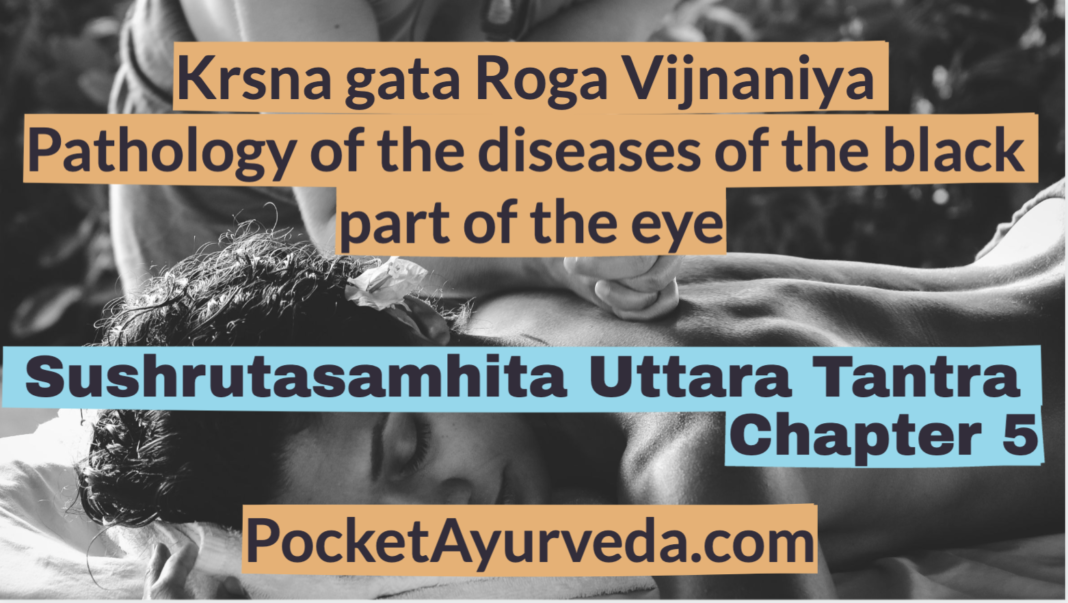पञ्चमोऽध्यायः अथातः कृष्णगतरोगविज्ञानीयमध्यायं व्याख्यास्यामः, यथोवाच भगवान् धन्वन्तरिः ॥ १ ॥
Now we shall discourse on the chapter which deals with the pathology of the diseases of the black part of the eye- choroid including the Iris (Krsna-gata Roga-Vijnaniya). 1.
यत् सव्रणं शुक्रमथाव्रणं वा पाकात्ययश्चाप्यजका तथैव | चत्वार एतेऽभिहिता विकाराः कृष्णाश्रयाः संग्रहतः पुरस्तात् ॥ २ ॥
The diseases which are bound to invade the region of the Choroid including the Iris (Krsna-mandala) have been briefly said to be four in number. Their names are Sa-vrana – Sukra, A-vrana-Sukra, Pakatyaya and Ajaka.2.
निमग्नरूपं हि भवेत् तु कृष्णे सूच्येव विद्धं प्रतिभाति यद् वै । स्रावं स्रवेदुष्णमतीव रुक् च तत् सव्रणं शुक्र ( क्ल )मुदाहरन्ति ॥ ३ ॥ दृष्टे: समीपे न भवेत् तु यच्च न चावगाढं न च संस्रवेद्धि | अवेदनावन्न च युग्मशुक्रं तत् सिद्धिमाप्नोति कदाचिदेव ॥ ४ ॥
Symptoms — A puncture-like dip in the region of the (Krsnamandala) with a sensation there as if the part has been pricked with a needle and attended with an excruciating pain and a hot exudation is called Sa-vrana-Sukra. If the seat of this disease is considerably remote from the pupil-entire part of the Drsti (Retina) be marked by the absence of pain and discharge and be not deep-seated and if there be not double spots, it offers very little chance of remedy. 3-4.
विच्छिन्नमध्यं पिशितावृतं वा चलं सिरासक्तमदृष्टिकृच्च । द्वित्वग्गतं लोहितमन्ततश्च चिरोत्थितञ्चापि विवर्जनीयम् ॥ ५ ॥ उष्णाश्रुपातः पिडका च कृष्णे यस्मिन् भवेन्मुद्गनिभञ्च शुक्रम् । तदप्यसाध्यं प्रवदन्ति केचिदन्यच्च यत् तित्तिरिपक्षतुल्यम् ॥ ६॥ सितं यदा भात्यसितप्रदेशे स्यन्दात्मकं नातिरुगश्रुयुक्तम् । विहायसीवाच्छघनानुकारि तदव्रणं साध्यतमं गम्भीरजातं बहलञ्च शुक्रं चिरोत्थिञ्चापि वदन्ति वदन्ति । कृच्छ्रम् ॥ ७॥
Symptoms and prognosis of A-vrana-sukra – A long-standing case of this disease, if it is mobile, covered with shreds of flesh, vein-ridden, stretching down to the second layer of skin ( in the eye) obstructing the vision, severed in the middle and marked with a reddish tint in the extremities, should be deemed as incurable. Several authorities mention that the appearance of Mudga- like specks of films on the region of the Iris, attended with growths of pustules and hot lachrymations, should be like-wise regarded as incurable. The feature of its (speck) assuming the colour of the feather of Tittira bird is an additional indication of the incurable nature of this diseae. A whitish film appearing on the region of the Choroid including the Iris (Krsna) like a speck of transparent cloud in the sky, and attended with lachrymation and slight pain due to the eye-disease known as Abhisyanda (Ophthalmia — lit. secretion) is called the A-vrana-Sukra. This is easily curable. A case of Avrana-Sukra (non-ulcerated film) which is thickened, deep-seated and long-standing, may be cured only with the greatest difficulty. 5-7.
सञ्छाद्यते श्वेतनिभेन सर्वं दोषेण यस्यासितमण्डलन्तु । तमक्षिपाकात्ययमक्षिकोप-समुत्थितं तीव्ररुजं वदन्ति ॥ ८ ॥
अजापुरीषप्रतिमो रुजावान् सलोहितो लोहितपिच्छिलाश्रुः । विदार्य कृष्णं प्रचयोऽभ्युपैति तञ्चाजकाजातमिति व्यवस्येत् ॥ ९ ॥
The appearance of a whitish milky film over the black part of the eye slowly shrouding it entirly with its mass and attended with acute pain is known as the Aksi-Pakatyaya. This is invariable found to result from an attack of Aksi-kopa¹ and is due to the concerted action of all the Dosas. A painful reddish growth, like the dung of a goat, found to shoot forth from beneath the surface of black part and attended with reddish slimy secretion is called an Ajaka. 8-9.
इति सुश्रुत संहितायामुत्तरतन्त्रे कृष्णगतरोगविज्ञानीयो नाम पञ्चमोऽध्यायः॥५॥
Thus ends the fifth chapter of the Uttara-Trantra in Susruta Samhita which treats of the pathology of the diseases of the black part of the eye.
1. According to Madhava’s reading in his Nidana, this disease need not necessarily rusult from an attack of Aksi-popa, and there need not be an actue pain, and it would be incurable.




